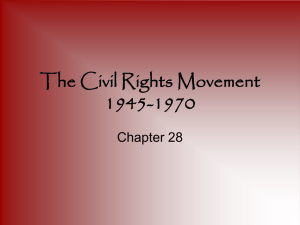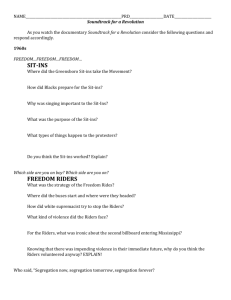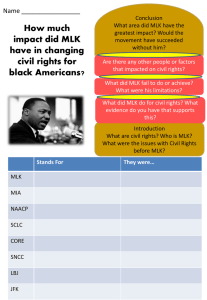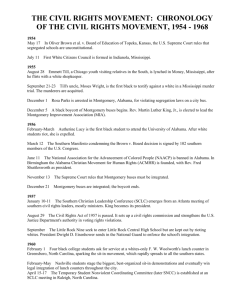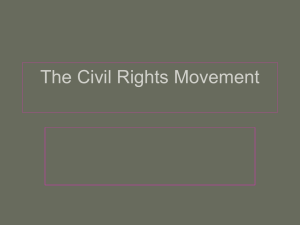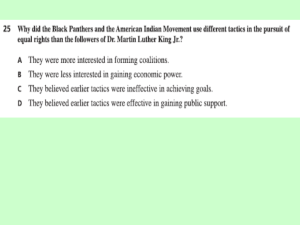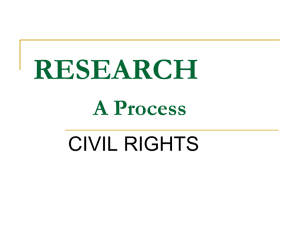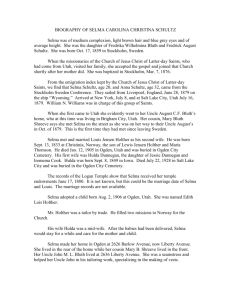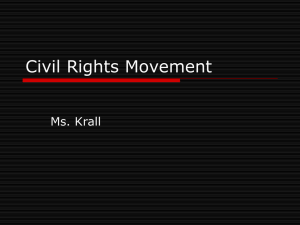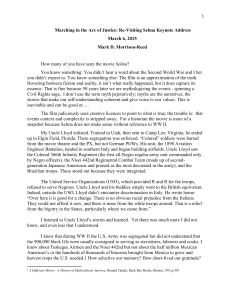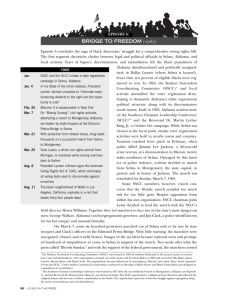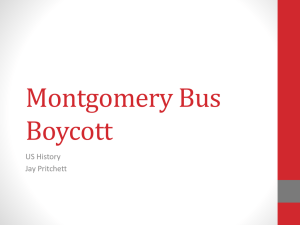“We Shall Overcome” - Clovis Online School
advertisement
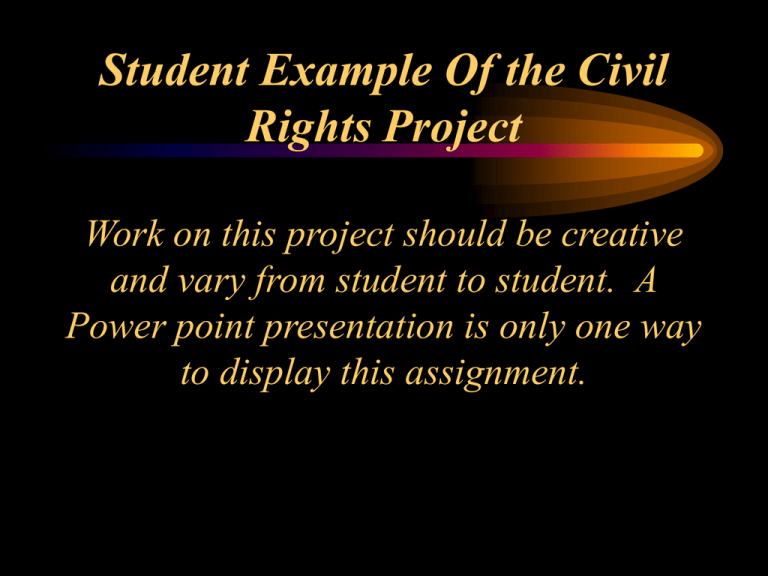
Student Example Of the Civil Rights Project Work on this project should be creative and vary from student to student. A Power point presentation is only one way to display this assignment. “More than a hamburger…” • A History of the Civil Rights Movement Ella Baker The civil rights movement began in 1863 with the signing of the Emancipation Proclamation by President Lincoln. This proclamation freed all slaves held in states still fighting in the Civil War. Amendments to the Constitution In 1865 the Thirteenth Amendment to the Constitution made slavery illegal in all areas of the United States. In 1868 the Fourteenth Amendment to the Constitution made all former slaves and all other persons who had been born in the United States or had been naturalized, a citizen of the United States. This amendment also granted all citizens equal protection under the law.. In 1879 the Fifteenth Amendment to the Constitution made it illegal to deny any citizen the right to vote because of race, color or the fact that he/she was a former slave. In 1857 the Supreme Court case of Dred Scott v. Sanford ruled that Scott, who had been a slave in Missouri, moved to the free territory of Wisconsin for 2 years and returned to Missouri, was not free. The court held that the Framers of the Constitution did not intend for people of African descent to be U.S.citizens. The court also held that Congress did not have the right to deprive anyone of personal property and could not exclude slavery from any federal territory. In 1896 the Supreme Court case of Plessy v. Ferguson ruled that State governments could separate people of different races as long as the facilities that were provided were of equal quality. The “separate, but equal” ruling was upheld until 1954. School Desegregation • May 17, 1954 the Supreme Court case of Oliver Brown v. Board of Education of Topeka ruled end to segregation • Chief Justice Warren…”Today education is perhaps the most important function of state and local governments…is a right which must be made available to all on equal terms.” School desegregation cont… • May 31, 1955-Supreme Court ruling on Brown v. Board of Education rejected NAACP plea to order instant and total school desegregation. • Made desegregation a gradual process • 1957 Little Rock, Arkansas desegretion of Central High Central High September , 1957 • Nine black students entered Central High September 23, 1957 under police protection • Photo-Elizabeth Eckford, one of “Little Rock Nine” Non-Violence in the Civil Rights Movement Montgomery Bus Boycott 1955 • Rosa Parks was arrested and removed from a bus in Montgomery Alabama for refusing to give up her seat to a white man • Sparked a city wide bus boycott • First involvement of a young minister named Martin Luther King Boycott cont….. • The Montgomery Bus Boycott caused a loss of 65% of the normal income for the bus company • 8 months later the Supreme Court ruled bus segregation unconstitutional Civil Rights Act of 1957 • Created authority for the establishment of a civil rights office in the Department of Justice. • First civil rights laws enacted since the immediate post Civil War period. • Dec. 9, 1957 the Civil Rights Division was established to enforce all federal statutes involved with civil rights and investigate complaints of violation of the civil rights laws. • Made it a federal crime to prevent persons from voting in federal elections. 1957 Organizations Founded • Southern Christian Leadership Conference (SCLC) with purpose of raising funds, coordinating local protests, and training black leaders • Student Nonviolent Coordinating Committee (SNCC) to develop and link sit-ins, organize freedom rides, voter registration drives and other protest activities. Organizations cont… • Feb. 1957, SCLC met in New Orleans and elected Martin Luther King Jr. president and Ralph Abernathy treasurer. • SCLC preached that nonviolence “transforms weakness into strength and breeds courage in the face of danger”. • SCLC became the driving force in the civil rights movement. Rev. Martin Luther King Jr. • Born 1948, Atlanta, GA. • PhD Boston Univ. 1955 • Pastor of Baptist church in Montgomery, AL • Led Montgomery bus boycott • 1957 formed SCLC • 1958 stabbed in Harlem on speaking tour • 1962 arrested and jailed in Albany, GA. King cont… • Birmingham, April 12, 1963 arrested with Ralph Abernathy for demonstrating without a permit. • 1963, June lead 125,000 person Freedom Walk in Detroit • 1964 Time magazine’s “Man of the Year” • 1964 Awarded Nobel Peace Prize-youngest ever to receive (35) • 1965 arrested in Selma • 1967 Announced inception of “Poor Peoples’ Campaign” for jobs and housing • 1968 Assassinated April 4 in Memphis Sit-ins • On Jan. 31, 1960, Joseph McNeil was refused service at a lunch counter at the bus terminal in Greensboro, NC. • NcNeil and three other freshmen from NC Agricultural and Technical College staged the first sitin at a Woolworths lunch counter in Greensboro Sit-ins cont…… • McNeil was joined by more black students and three whites on succeeding days to fill all the seats at the counter. • Inspired sit-ins all over the South-Durham, Winston-Salem, Charlotte, Raleigh and into Virginia. • Civil rights activist, Ella Baker, termed the sit-ins “More than a hamburger”. • Feb. 12, 1961-Tallahassee sit-in turned into a “jailin” when all those arrested refused to pay the fines and took their 60 day sentence. Freedom Rides-1961 • March 13, 1961-Supreme Court extended its prohibition against segregation in vehicles engaged in interstate travel to include all terminal accommodations. • Freedom rides were set up to test Jim Crow laws in terminal restaurants, waiting rooms and rest rooms. Freedom Rides cont……. • May 4, 1961-7 blacks and 6 whites split into 2 interracial groups and boarded buses in Washington D.C. • Rock Hill, SC. One black was beaten attempting to enter a waiting room. • May 14-Mothers’ Day-Anniston, Alabama, freedom rider bus attacked and burned. Medical treatment for burned and wounded blacks was withheld. University of Mississippi Riot1962 • James Meredith applied for admission to the University of Mississippi. • With help from Medgar Evers, NAACP leader, a federal court order gave Meredith entrance. • Throng of over 2000 came on campus to protest Meredith’s admission. University of Mississippi Riot cont…. • Confederate flag waving students surrounded the administration building. • Meredith was taken to a dormitory under cover of darkness by 15 marshals. • Riot erupted resulting in 2 deaths and 75 injuries. Winona Mississippi-June 9, 1963 • Four young women were arrested as they returned from a movement workshop • Fannie Lou Hamer, Annell Ponder of the SCLC, Euvester Simpson, and June Johnson were jailed with three of them beaten. • When Lawrence Guyot attempted to bail them out, he also was beaten. Dr. Martin Luther King and Birmingham 1963 • Martin Luther King provoked a confrontation in Birmingham, Alabama in 1963 • Started a wave of nonviolent action-”The Negro Revolution” • King and Rev. Abernathy in photo Birmingham cont… • Injunction filed to prohibit racial protests. • King and Rev. Shuttlesworth led sit-ins and marches on City Hall. • Protestors were attacked by police dogs. • King was jailed, and while incarcerated, wrote his famous 19 page letter-”Letter from the Birmingham Jail”. • Birmingham blacks staged an economic boycott. Birmingham cont… • May 2-King staged a children’s march of over 1000 black children. • May 3-firemen aimed firehoses at children assembled with King. • Over 1300 arrested in 2 days-adults and children 1963 The March on Washington D.C. March on Washington • Philip Randolpf and Bayard Rustin organized a march on Washington. • The march proceeded from the Washington Monument to the Lincoln Memorial in a peaceful parade. • Over 200,000 including 75,000 whites participated in the march. • Joan Baez sang “We Shall Overcome”; Peter, Paul and Mary sang “How Many Roads?” and Bob Dylan performed the “Ballad of Medgar Evers” to commemorate his death. Mississippi, June, 1964 • Three civil rights workers who were working on registering blacks for voting were killed by the Ku Klux Klan and buried in an earthen dam of a cattle pond. • Bodies of Mickey Schwerner, James Chaney and Andrew Goodman were found on Aug. 4, 1964 • The Mississippi Freedom Democratic Party was formed –80,000 people joined Civil Rights Act 1964 • Authorized massive use of federal authority to combat privately imposed racial discrimination. • Title II- federal offense to discriminate against any person in place of public accommodation because of race, color, religion or place of origin. • Title VII -Illegal for any employer or union to discriminate in employment practices against anyone because of race, color, religion or place of origin. Selma to Montgomery March 1965 • Martin Luther King attempted to lead a march on March7 from Selma, Alabama to Montgomery. • Purpose was to appeal to Gov. Wallace to stop violence such as the the killing of a protestor by a state trooper in Marion, Alabama. • Wallace refused to allow the march. Selma to Montgomery cont… • King met with Pres. Johnson and set march for the 8th of March. • Protestors decided to march on the 7th without King. • Marchers were met by state troopers and charged upon at the Pettus Bridge just outside Selma. They attacked praying protestors with night sticks and tear gas. Selma to Montgomery cont… • Troopers advance on marchers outside Selma. Selma to Montgomery cont… • The beatings of many of the marchers led to the naming of the Selma march, “Bloody Sunday” • The following Tuesday King led a march to the Selma bridge where one marcher was killed. • March 25, King led a successful march from Selma to Montgomery with Pres. Johnson’s permission. • The Voting Rights Act was passed that year. Voting Rights Act of 1965 • The 14th and 15th Amendments to the Constitution were not followed in the South. • Social pressure, violence, and terrorist activities of the Ku Klux Klan including lynchings kept black people from voting. • In 1944 the Supreme Court case of Smith v. Allwright declared the “white primary” unconstitutional. White primaries were operated by the Democratic party, which was the only party in the South, and public officials were “chosen”. Voting Rights Act 1965 cont… • Poll taxes, which the blacks could not afford, were in place in the South. • Literacy tests were given to blacks and scored by the So. Democrats to eliminate the black vote Voting Rights Act 1965 cont… • Result of plea by Pres. Johnson to “ensure that no person could be deprived of the right to vote in any election for any office because of race or color”. • Section 2 of the act prohibits voting qualifications that address race or color. • Authorized appointment of federal examiners to register voters in areas that had been discriminating. Voting Right Act 1965 cont… • 1993 Supreme Court case of Shaw v. Reno ruled it unconstitutional to create a congressional district using race as the sole reason for drawing the district lines. • Congressional district may include a majority of minority voters as long as race was not the only factor used in drawing the lines. Those who opposed the nonviolent protests and advocated “Black Power” and aggressive resistance. Stokely Carmichael-SNCC • Carmichael became the leader of the SNCC after John Lewis • Began a “battle for self-determination” along with Floyd McKissick from CORE. • King attempted to temper the violence tendencies in the Meredith March Against Fear from Memphis to Jacksondid not prevail • Carmichael was arrested along the march for pitching a tent on the grounds of a black high school. • Began the chant, “We want Black Power!” • Under Carmichael, the SNCC abandoned all pretense of working within the movement. • Helped to organize the Black Panther party. Malcolm X • Promoted a “global rebellion of the oppressed against the oppressor”. • Responsible for the growing militancy of the black population • Leader of the Black Muslims • Did not want an end to separatism • Created the Organization of Afro-American Unity • Assassinated Feb. 20, 1965 in Harlem by Black Muslims. Affirmative Action • One major result of the civil rights movement was establishment of affirmative action. • Affirmative action provides equal opportunities for minorities. • Often termed “reverse discrimination’ by opponents. • Challenged in the famous case Bakke v. University of California Regents where Allen Bakke charged the university with reverse discrimination . • Set quotas of minorities resulted from affirmative Affirmative Action cont… • Has been challenged numerous times in the Supreme Court with some cases upheld and some overruled. • Case of Adarand v. Pena, in which Adarand Constructors, Inc. sued respondent officials over race-based presumptions used in subcontractor compensation clause, held that it violated the equal protection component of the Due Process Clause of the Fifth Amendment. The subcontractor clause granted a prime contractor a financial incentive to hire sub-contractors who were socially and economically disadvantaged individuals. • Richmond v. Croson in 1989 was a similar case involving minority sub-contractors and a 30% quota for hiring-court struck down that regulation. Strength of Conviction The Civil Rights Movement was a success because it was a true “movement” of the people who believed in what they were doing . Hundreds of thousands of citizens, both black and white, banded together in support for the granting of civil rights to all Americans. The activists were working not only for themselves, but for their fellow citizens of all races and colors. The players in the drama that unfolded were not just special interest groups who sought to gain some type of power or monetary advancement, but people who cared about each other and the rights of all of their fellow humans. Although the civil rights of all are still not 100% enforced, the United States is a much better place because of those who gave some, or all, for
